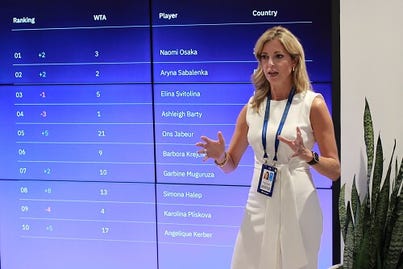IBM Showcases Strategic Digital Changes at the 2021 US Open
Crunching sports data and making it presentable to tennis fans continues even with the return of live audience in the stands.

With spectators back in the stands for the first time since the start of the pandemic, the 2021 United States Open Tennis Championships (US Open) tournament faces its new normalcy -- and the sports data analysis conducted during the event by IBM is no exception.
Continuing a relationship that stretches back about 30 years, IBM’s Open Hybrid Cloud, Watson, and other resources are put into play processing mountains of data generated by the performance of the competitors. As seen in years prior at the US Open, this can include working with unstructured data that must be transmuted into something more useable.
Though the 2020 US Open tournament was held, the COVID-19 pandemic forced the event to go remote with no audience in the stands. That was made possible in part through cloud technology that IBM made available. The 2021 tournament brought the introduction of IBM Power Rankings with Watson, which are AI-powered daily rankings of player performance at the US Open.
This year, in-person attendance resumes with proof of vaccination and other procedures in place to better ensure fan safety. Tuesday night of the US Open saw up-and-comer Holger Rune serve up a surprising challenge to Novak Djokovic, currently ranked as the men’s singles world No. 1 by the Association of Tennis Professionals. Top-seeded Djokovic won the match ultimately.

Holger Rune during the first round of the 2021 US Open. Credit: Joao-Pierre S. Ruth
Restrictions and changes necessitated by the ongoing COVID-19 pandemic also meant IBM could not offer a walkthrough of their technology centers behind the scenes at the Arthur Ashe Stadium in Queens, as was done in the past.
Still, the company gave a glimpse on Tuesday night into how it continues to turn fresh and historic data gathered from competitors at the US Open into content such as Power Rankings and projections on upcoming matchups.
The scale of the US Open, in terms of audience size and data, is substantial. “This is the largest annually attended sporting event in the world,” said Lewis Sherr, chief revenue officer with the United States Tennis Association (USTA), which hosts the tournament. Under normal circumstances, more than 850,000 fans attend the US Open in-person over the course of three weeks. The audience scale expands further when accounting for viewership from around the world. “We’re much more like an Olympic Games or World Cup than we are NBA or NFL teams that are domestically focused,” he said.
USTA’s relationship with IBM predates the existence of websites and evolved further of late in response to the pandemic. “The work we’re doing, leveraging cloud capabilities to be more efficient operationally, leveraging AI capability to allow our fans to engage more deeply in match analysis … it really is a testament to IBM’s ability to stay current and keep us at the leading edge in sports and entertainment tech,” Sherr said.
The work done by USTA and IBM over the decades to bring the tournament to fans wherever they are essentially fed into their strategy to adapt to the pandemics, said Kirsten Corio, USTA’s managing director of ticket sales, hospitality, and digital strategy. “It’s been part of our mission for years pre-pandemic."

Kirsten Corio, USTA’s managing director of ticket sales, hospitality, and digital strategy. Credit: Joao-Pierre S. Ruth
Bringing the US Open to fans in a digital way includes scores, stats, Power Ranking, and play schedule, Corio said, as well as increases engagement with casual tennis fans who might not be well-versed in all its nuances or newer players. “[Power Rankings] dovetails nicely into some of the other features and functionality we’ve built that look at AI in a way that helps educate the fan,” she said.
Deconstructing what led to some of the more recent capabilities developed for the USTA and the US Open -- it all started with the data, said John Kent, program manager for IBM’s sports and entertainment partnerships. Fans in the stands and viewers at home might see just a few data points such as serve speed during matches, but he said even more can be found below the surface. “There’s a lot of data floating off the court,” Kent said. “That’s what we call structured data. Player position, ball position, all that’s aggregated in. But with the use of AI, articles and blogs and video are data.”
Structured data such as how the player is performing factors into the power rankings, but he said they also can monitor what sports pundits are saying to better determine those power rankings. This also offers some opportunity to predict the potential outcome of matches, derived from data. “We can put for any head-to-head match the likelihood of a player to win,” Kent said.
IBM Open Hybrid Cloud enabled such computing power, he said, along with Red Hat OpenShift technology for development. “The subset applications for Power Rankings and match insights, there’s multiple applications,” Kent said. “They have different needs.” He said hybrid cloud offers the flexibility for connectivity most everywhere.
Related Content:
IBM Puts Red Hat OpenShift to Work on Sports Data at US Open
IBM Esports and Interxion Talk Lessons from Cloud Gaming Tech
Topspin and Terabytes: IBM Ups Its Cloud Game at the Masters
About the Author
You May Also Like






